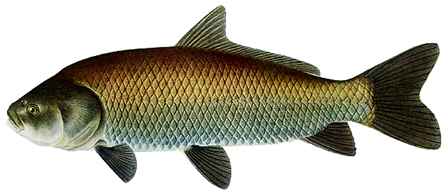
Ictiobus Rafinesque

In Ichthyologia Ohiensis Rafinesque (1820: 111) described Ictiobus as a subgenus under genus Catostomus, but distinguished the group as having a nearly cylindrical body. Into this group he described two new species: Catostomus bubalus and C. niger. C. bubalus was described as having a sloping head, rounded snout, small eyes, large scales and an olivaceous brown coloring, with black and brown fins (Rafinesque 1820:112). He described C. niger without having ever seen a specimen, relying instead on an account provided by John James Audubon. C. niger was described as completely black and "entirely similar to the common buffalofish, but larger" (Rafinesque 1820:112-113). Rafinesque also listed LeSueur's (1817) C. gibbosus and C. communis under Ictiobus, commenting that they were intermediate in form between Moxostoma (the first of his five new subgenera) and Ictiobus. Valenciennes in Cuvier and Valenciennes (1844) described Sclerognathus cyprinellus from Lake Pontchartrain near New Orleans as a form simlar to Catostomus cyprinus LeSueur.
On examining pharyngeal teeth of species he had described a year earlier as Carpiodes, Agassiz (1855) determined that one group had triangular teeth that inceased in size and thickness along the upper margin of the bone. These species - Carpiodes urus, C. taurus, and C. vitulus - were reclassified under new genus Bubalichthys, together with Catostomus niger Rafinesque, which was removed from Ictiobus, and his new species B. bonasus from the Osage River, Missouri. Agassiz (1855:80) characterized the pharyngeal teeth of Rafinesque's Ictiobus (respelled Ichthyobus) as intermediate between the flatter teeth of Carpiodes and the more triangular teeth of Bubalichthys. He described I. rauchii from Iowa as having a higher dorsal fin and other fins longer than in I. bubalus, and I. stolleyi from the Osage River, Missouri, as steeper in profile, with a blunter snout and larger opercular bones than in I. rauchii (Agassiz 1855:81-81).
A species which Baird and Girard (1854) had described as Carpiodes tumidus was reclassified under genus Ictiobus by Girard (1856). Gunther (1868) described Schlerognathus meridionalis from the Rio Usumacinta, Guatemala. Cope (1870:480) commented on Agassiz's (1855) assertion that catostomid genera are well distinguished by the nature of their pharyngeal teeth, claiming that this is not wholly the case: "Bubalichthys is well characterized by the form of [the] pharyngeal bone...but the remaining Rafinesque genera Carpiodes and Ictiobus are but doubtfully distinct from one another."
Jordan and Evermann (1896) regrouped species in genus Ictiobus under two subgenera: Sclerognathus, in which they classifed I. cyprinella; and Ictiobus, in which he placed Carpiodes urus Agassiz, Schlerognathus meridionalis Gunther, and I. bubalus Rafinesque. Meek (1904) described Carpiodes labiosus from the Rio Panuco of Mexico.
Hubbs (1930) placed C. urus Agassiz, C. taurus Agassiz and C. tumidus Baird and Girard (removed from synonymy of C. velifer) in the synonymy of I. bubalus Rafinesque. He placed C. vitulus Agassiz and B. bonasus Agassiz (which he claimed were based on the same form), and I. urus of later authors, in the synonmy of I. niger. Hubbs placed I. rauchii Agassiz and I. stolleyi Agassiz in the synonmy of Megastomatobus cyprinella. The new genus name was offered to emphasize the distinctiveness of Sclerognathus cyprinellus, while avoiding the fact that the name Sclerognathus incorporates two distinctive forms of ictiobines (Agassiz 1855: 81). Subsequent authors failed to retain this emphasis however, treating M. cyprinella (Valenciennes) as a specialized form of genus Ictiobus.